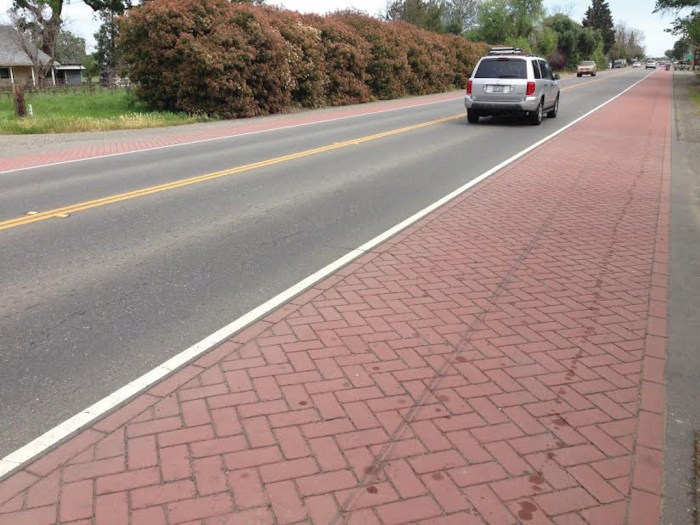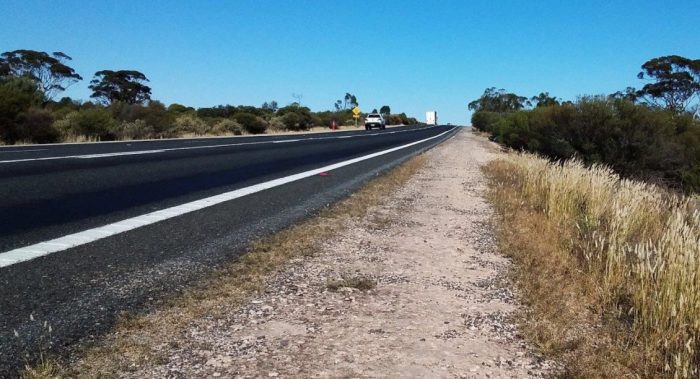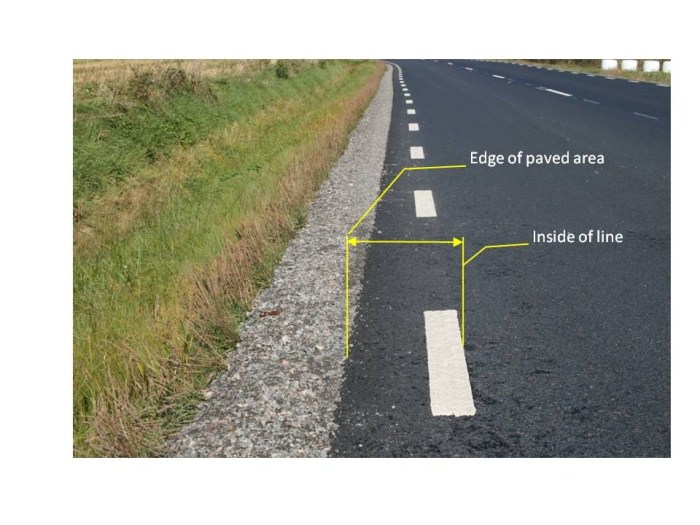Unpaved shoulder of the road – Unpaved shoulders play a crucial role in enhancing road safety and optimizing road performance. These often-overlooked elements provide a safe haven for vehicles in emergencies, reduce accidents, and contribute to sustainable road design. Dive into this comprehensive exploration of unpaved shoulders, uncovering their significance and offering practical solutions for their effective design, maintenance, and use.
From exploring different shoulder designs and materials to understanding the intricate interaction between pavement and shoulder, this discourse provides a thorough examination of the topic. Discover how unpaved shoulders can improve road safety, mitigate environmental impacts, and contribute to a more efficient transportation system.
Road Safety and Unpaved Shoulders

Unpaved shoulders play a critical role in enhancing road safety and reducing the severity of accidents. They serve as a buffer zone between the traveled way and adjacent areas, providing several safety benefits.
Wider and better-maintained shoulders allow vehicles to safely pull over in case of emergencies, such as mechanical failures or sudden health issues. This reduces the risk of rear-end collisions and other accidents caused by vehicles stopped on the traveled way.
Accident Prevention
- Unpaved shoulders provide a safe haven for vehicles to pull over during emergencies, reducing the risk of accidents.
- Wider shoulders give drivers more time to react to hazards and avoid collisions.
- Well-maintained shoulders prevent vehicles from getting stuck or losing control due to uneven surfaces or debris.
Shoulder Design and Maintenance

Unpaved shoulders play a crucial role in road safety by providing additional space for vehicles to maneuver in emergency situations and during inclement weather. Proper design and maintenance of unpaved shoulders are essential for their effectiveness and longevity.
Types of Shoulder Designs
- Stabilized Shoulders:These shoulders are constructed using a mix of aggregate and binder, providing a stable surface that can withstand heavy traffic. They offer good drainage and can be easily repaired.
- Gravel Shoulders:Made of loose gravel, these shoulders are less expensive to construct but require more frequent maintenance. They can be susceptible to erosion and rutting during heavy rainfall.
- Turf Shoulders:These shoulders are vegetated with grass or other plants, providing a natural and environmentally friendly option. However, they require regular mowing and can be slippery when wet.
Importance of Shoulder Maintenance
Proper maintenance of unpaved shoulders is crucial to ensure their safety and functionality. This includes:
- Grading:Regular grading helps to maintain a smooth and even surface, preventing the formation of ruts and potholes.
- Drainage:Adequate drainage is essential to prevent water from accumulating on the shoulder, which can lead to erosion and instability.
- Vegetation Control:Vegetation can obstruct visibility and create hazards for vehicles. Regular mowing or trimming is necessary to keep vegetation under control.
Recommendations for Improvement
- Use of Geosynthetics:Geosynthetics, such as geotextiles and geogrids, can be used to reinforce unpaved shoulders, improving their stability and resistance to erosion.
- Improved Drainage Systems:Installing proper drainage systems, such as culverts and ditches, can effectively prevent water accumulation and reduce the risk of shoulder damage.
- Regular Inspection and Maintenance:Regular inspection and timely maintenance are essential to identify and address any potential issues before they become major problems.
Pavement-Shoulder Interaction
The interaction between the pavement and the shoulder plays a critical role in road performance. Proper pavement-shoulder interaction ensures smooth traffic flow, enhances safety, and extends the lifespan of the road.
When the pavement and shoulder are not properly integrated, several problems can arise, including shoulder drop-offs, pavement cracking, and rutting. These issues can compromise road safety and lead to costly repairs.
Unpaved shoulders of the road can be dangerous for vehicles, especially when wet. The lack of traction can cause cars to skid or hydroplane. In order to avoid accidents, drivers should be aware of the potential hazards of unpaved shoulders and take precautions, such as slowing down and avoiding sudden maneuvers.
A box weighing 77.0 n rests on an unpaved shoulder is particularly susceptible to these hazards, as the weight of the box can cause it to sink into the soft ground and become stuck.
Causes of Shoulder Drop-Offs and Other Pavement-Shoulder Failures
- Differential Settlement:Differences in soil conditions or compaction between the pavement and shoulder can cause the shoulder to settle at a different rate, leading to a drop-off.
- Erosion:Water runoff from the pavement can erode the shoulder, especially if the shoulder is not properly sloped or stabilized.
- Traffic Loading:Heavy traffic loads can compress the shoulder material, causing it to sink and create a drop-off.
- Poor Drainage:Inadequate drainage can lead to water accumulation in the shoulder, weakening the material and causing it to fail.
- Lack of Maintenance:Regular maintenance, such as grading and sealing, is essential to prevent shoulder deterioration and drop-offs.
Solutions for Mitigating Pavement-Shoulder Interaction Problems, Unpaved shoulder of the road
- Proper Design:The pavement and shoulder should be designed together to ensure compatibility and minimize differential settlement.
- Compaction:Both the pavement and shoulder should be properly compacted to prevent uneven settlement.
- Adequate Drainage:Proper drainage systems should be installed to prevent water accumulation and erosion.
- Erosion Control:The shoulder should be sloped and stabilized to prevent erosion from water runoff.
- Regular Maintenance:Regular grading and sealing of the shoulder are essential to prevent deterioration and drop-offs.
Unpaved Shoulder Materials

Unpaved shoulders are constructed using various materials, each with unique properties and suitability for specific conditions. These materials can be broadly classified into two categories: granular and non-granular.
- Granular materials, such as gravel, crushed stone, or sand, are composed of small, loose particles that interlock to provide stability. They are commonly used in areas with moderate traffic volumes and stable soil conditions.
- Non-granular materials, such as soil, turf, or vegetation, are composed of finer particles that are not as well-suited for high-traffic applications. They are often used in low-traffic areas or as a temporary measure until more permanent materials can be installed.
When selecting shoulder materials, several factors must be considered, including:
- Traffic volume: High-traffic roads require materials that can withstand repeated loads and resist wear and tear. Granular materials are typically preferred in these situations.
- Climate: The climate of the area can affect the performance of shoulder materials. For example, in areas with heavy rainfall, materials that are resistant to erosion and moisture damage are necessary.
- Soil conditions: The type of soil present at the site can influence the choice of shoulder materials. Soft or unstable soils may require additional reinforcement or stabilization measures.
In general, the following recommendations can be made for selecting and using shoulder materials:
- For high-traffic roads, use granular materials such as gravel or crushed stone.
- For low-traffic roads or temporary applications, non-granular materials such as soil or vegetation may be suitable.
- Consider the climate and soil conditions when selecting materials. For example, in areas with heavy rainfall, use materials that are resistant to erosion and moisture damage.
- Ensure that the materials are properly compacted and maintained to ensure their long-term performance.
Environmental Considerations: Unpaved Shoulder Of The Road

Unpaved shoulders can have a range of environmental impacts, including erosion, sedimentation, and water quality issues. Erosion occurs when the soil on the shoulder is washed away by water or wind, leading to the loss of soil and the formation of gullies.
Sedimentation occurs when the eroded soil is deposited in waterways, causing turbidity and clogging fish gills. Water quality can also be affected by the runoff from unpaved shoulders, which can contain pollutants such as sediment, nutrients, and pesticides.
There are a number of solutions that can be used to mitigate the environmental impacts of unpaved shoulders. These include using erosion control measures such as vegetation, riprap, or geotextiles, and planting vegetation on the shoulder to help hold the soil in place.
Unpaved shoulders can also contribute to sustainable road design by providing a buffer between the road and the surrounding environment, helping to reduce noise and air pollution, and providing habitat for wildlife.
Erosion Control Measures
- Vegetation: Planting vegetation on the shoulder is an effective way to control erosion. The roots of the plants help to hold the soil in place, and the vegetation itself can help to slow down the flow of water and trap sediment.
- Riprap: Riprap is a layer of large rocks or boulders that is placed on the shoulder to protect it from erosion. Riprap is often used in areas where the shoulder is subject to high levels of water flow.
- Geotextiles: Geotextiles are synthetic fabrics that are placed on the shoulder to help prevent erosion. Geotextiles allow water to pass through them, but they trap sediment and help to hold the soil in place.
FAQ
What are the primary functions of unpaved shoulders?
Unpaved shoulders serve multiple purposes, including providing a safe area for vehicles to pull over in emergencies, reducing accidents by providing a buffer zone between traffic lanes and obstacles, and improving road drainage.
How can unpaved shoulders contribute to sustainable road design?
Unpaved shoulders can contribute to sustainable road design by reducing erosion and sedimentation, improving water quality, and providing habitat for wildlife. They can also help reduce the urban heat island effect and mitigate the impacts of climate change.